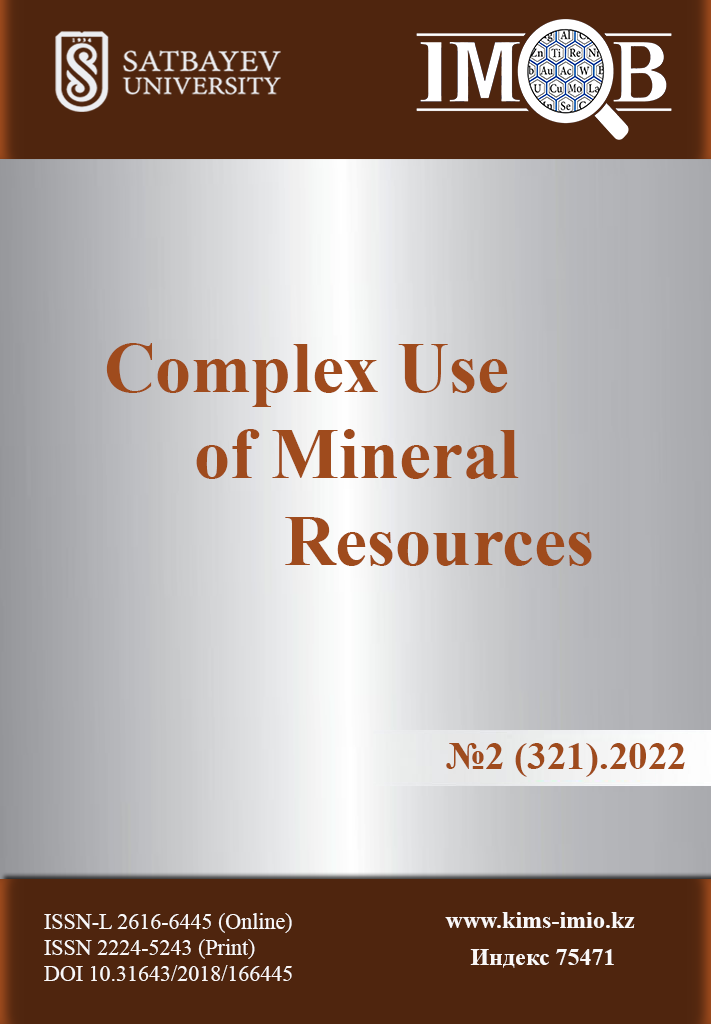Thermodynamic substantiation of compositions of silicon aluminium alloys with increased aluminium content in Fe-Si-Al system
DOI:
https://doi.org/10.31643/2022/6445.15Keywords:
phase diagrams, Bjerrum-Guggenheim coefficient, crystallization regions of phases, silicon aluminium alloys, ferrosilicon aluminium, complex alloys.Abstract
A priority direction of ferrous metallurgy development is to increase in output of the high quality metal and metal products of new assortment. One of the methods to improve a quality of steels is to involve of complex alloys based on aluminum, silicon, manganese, etc. for their output. They are necessary as deoxidizing agents and alloying additives. This paper considers the possibility of the thermodynamic substantiation of the aluminum solubility in the ferrosilicon-aluminum complex alloy (FeSiAl) on the basis of their phase diagrams using the osmotic coefficient of the Bjerrum-Guggenheim. Methodology used is based on the theoretical studies of the phase equilibria using the Bjerrum-Guggenheim concept. It includes a set of computer programs in C# language (C sharp) designed to evaluate a deviation scope of properties of a real system from the ideal one. Criterion for evaluation is an osmotic coefficient of the Bjerrum-Guggenheim. The pattern of change in an osmotic coefficient of the Bjerrum-Guggenheim on the ratio of activity of components in the ideal liquid and solid phases (positive Фi <1 or negative Фi >1) under the boundary forming conditions of crystallization regions of phases related to the melting ferrosilicon-aluminum processes is a direct proof of the possibility to use it as a metal reducing agent. The calculated mathematical dependences of the osmotic coefficient of the Bjerrum-Guggenheim permit us to determine the crystallization temperature of the ferrosilicon-aluminum alloy. The alloying process with rich aluminum content is observed at this temperature. The dependence diagrams of an osmotic coefficient of the Bjerrum-Guggenheim of a crystallizing component on the ratio of its activity in the liquid and solid phases demonstrated that a temperature rise leads to strong negative deviations in silicon properties, and thus to its good mixability in the melt with iron and aluminum. Compositions of silicon-aluminum alloys with high aluminum content in the ferrosilicon-aluminum complex alloy (FeSiAl) were determined on the basis of their phase diagrams using the osmotic coefficient of the Bjerrum-Guggenheim with iron content of 12-37%, aluminum 20-25% and silicon 68-38%. The received theoretical results permit to determine conditions which give the maximum possible aluminum assimilation with the ferrosilicon-aluminum melts supplied from the high-ash coal in the melting process of this metal in the ore-thermal furnaces. Thus it is a direct method to develop the output technology of the complex alloys.
Downloads
References
GhosG. The phase equilibria and thermodynamic properties of the ternaryAl-Fe-Si system were analyzed and a complete. Ternary Alloys:A ComprehensiveCompendiumof Evaluated Constitutional Data andPhaseDiagrams, G.Petzow and G. Effenberg, eds., VCH Publishers, New York, NY. 1992. 5. 394–438.
Zi-Kui Liu, Austin Chang Y. Thermodynamic Assessment of the Al-Fe-Si System. Metall. Trans1999;30:1081-1095. https://doi.org/10.1007/s11661-999-0160-3
Issagulov AZ, ChekimbayevAZ, Makayev TS, Babenko AA.Studying the Fe-Al-Si system in relation to ferrosilicon-aluminum alloy crystallization. Metalurgija. 2020;59(1):81-84.
Zaharov AM. Diagrammy sostoyaniya dvojnyh i trojnyh sistem [Phase diagrams of binary and ternary systems]. Moscow: Metallurgy. 1978, 295. (inRuss.).
Hansen M, Anderko K. Struktura dvojnyh splavov[Structure of double alloys]. Moscow: Metallurgy. 1962,1488. (in Russ.).
Zaharov MA. Raschet osnovnyh tipov diagramm sostoyaniya binarnyh rastvorov v ramkah obobshchennoj reshetochnoj modeli [Calculation of key types of phase diagrams of binary solutions under the generalized lattice model]. Vestnik Novgorodskogo gosudarstvennogo universiteta = Bulletin of Novgorod State University. 2016;98(7):22-26.(in Russ.).
Voronin GF. Novye vozmozhnosti termodinamicheskogo rascheta i postroeniya diagramm fazovyh sostoyanij geterogennyh sistem [New possibilities of thermodynamic calculation and construction of phase diagrams of heterogeneous systems]. Zhurnal fizicheskoi himii = Russian Journal of PhysicalChemistry. 2003;77(10):1874-1883. (in Russ.).
Bajsanov S, Tolokonnikova VV, Narikbaeva GI, Korsukova IYa. Metody issledovaniya linij geterogennyhfazovyh ravnovesij na diagramme sostoyaniya cherez osmoticheskij koefficient B'erruma-Guggengejma [Research methods of the lines of heterogeneous phase equilibria on phase diagram using the osmotic coefficient of Bjerrum-Guggenheim]. Karaganda: Ekozhan.2020,73. (in Russ.).
Shahnazarov KYu. Priznaki promezhutochnyh faz v sistemah Al-Si, Fe-C, Al-Cu [Signs of intermediate phases in systems of Al-Si, Fe-C and Al-Cu]. Vestnik MGTU im. G.I. Nosova =Bulletin of Moscow State Technical University named after G.I. Nosov. 2016;14(3):71-77. (in Russ.).
BaisanovSO, Tolokonnikova VV, Narikbayeva GI, Korsukova IYa, Zhuchkov VI. Thermodynamic assessment of smelting of manganese and chromium ferroalloys based on the analysis of their state diagrams. Izvestiya NAN RK. Seriya «Khimii i tekhnologii» = Izvestia of the National Academy of Sciences of the Republic of Kazakhstan. The series "Chemistry and technology"2018;5:47-57. https://doi.org/10.32014/2018.2518-1491.7
Baisanov S, Tolokonnikova V, Narikbayeva G, Korsukova I, Mukhambetgaliyev Ye. Mathematical method of phase equilibrium of binary system Cr-Si based on Bjerrum -Guggenheim concept.Metalurgija. 2020;59(1):97-100.
Downloads
Published
How to Cite
Issue
Section
License
Copyright (c) 2022 Baisanov, S., Tolokonnikova, V., Narikbayeva, G., & Korsukova, I.

This work is licensed under a Creative Commons Attribution-NonCommercial-NoDerivatives 3.0 Unported License.


























